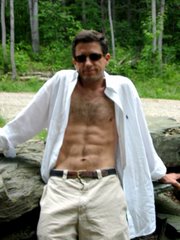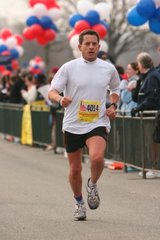Last month, my dad celebrated the 30th anniversary of his running streak.
In other words, he has run every day for 10,987 consecutive days. The last time he took a pass -- he was feeling a bit sore after a marathon -- was Oct. 30, 1978.
Obsessive doesn't begin to describe it.
When he travels overseas, my dad, who is 66, plans layovers so he can get in a couple miles around the concourse, lest he miss a day to the time-zone shift. During blizzards, he wraps his feet in plastic bags, pulls galoshes over his sneakers and screws in cleats for traction. Then he waits for a snowplow to pass his front door, so he can follow in the freshly cleared path.
My father, Dr. Harvey B. Simon, practices internal medicine in Boston and teaches at Harvard Medical School. Rationally, he knows that running 10 miles a day, every day, for three decades is not great for his ever-more-creaky body. He'd never advise his patients to do it. In fact, he's written several health and fitness books stressing the virtue of moderation in exercise. And yet....
He's run with broken toes and the flu and a nasty infected heel and near-crippling back spasms. He goes out before dawn in every kind of weather; he's become such a fixture in the neighborhood that a couple times when a freak thunderstorm has rolled in, strangers have driven out to find him. They didn't know his name. They just knew he'd be out there, plodding away, and figured he might appreciate a ride home.
My dad isn't alone in this nutty obsession. The U.S. Running Streak Association lists 31 members who have been running daily for 30 years or more. The reigning champ is a running coach out of California by the name of Mark Covert. He hasn't missed a day since he was 17. He's now 57.
Every streaker has a story of inspired persistence -- or, viewed another way, lunacy. One tells of holding his catheter aloft as he hobbled out after surgery. Another ran on a cruise ship -- during a tropical storm.
Ronald Kmiec, a concert pianist in Carlisle, Mass., jogged for four days through severe chest pains, until his wife dragged him to the hospital. Turned out he'd had a heart attack. He was so determined to keep the streak alive, he asked the nurse to take him to a treadmill. She nixed that idea, and his streak ended one day short of 32 years. (Undaunted, Mr, Kmiec got right back on the road and completed his 35th consecutive Boston Marathon five months later.)
Why do they do this? All kinds of reasons. Some streakers say they commune with God during their daily runs. Others think through knotty problems at work. The run structures the day; gives a sense of order to a hectic life.
As streakers grow older, their accomplishment also represents a triumph over aging. You don't give in to aches and pains; you conquer them. You don't wallow in anxiety; you lace up your sneakers. You feel, if not invincible, at least indomitable, and it's not hard to see why; if you're still doing at 66 the same thing you did at 36, you must be doing all right.
My dad started running for health reasons after my mom ordered him to lose weight. He has a family history of heart disease, and he soon found that regular exercise kept his cholesterol and blood pressure under control. I'm sure that's one motivation for the streak.
But the main reason, truly, is that he loves getting out there in the first rays of morning, letting his mind drift, with nothing to do but take the next step. He started the streak, he says, because he got tired of spending every cold, dark morning debating with himself about whether to go out. "I figured, why waste time debating? I'd just go out every day," he says. "So I did."
When people ask why he doesn't take just one day off, he shrugs and says, "I like to run."
Asked how he's kept at it so long, he responds: "Left, right, left, right."
His stride, never all that fluent, has broken down over the last 100,000 miles to the point that he now has what the family politely refers to as a "distinctive gait." His hip hurts. He's slow. And still... left, right, left, right.
When he hit 25 years, my dad talked about pulling a "Cal Ripken Jr.," after the Baltimore Orioles infielder who benched himself one day when he was perfectly healthy, putting an end to an incredible streak of playing in 2,632 consecutive games. Mr. Ripken had wanted to end the streak on his own terms, not wait for injury to force him out. My father said that sounded good. But I knew in my heart he'd never do it.
The streak is too much a part of him.
I worry about that sometimes. He's proud of his streak, and I think his running longevity -- the fact that he's prevailed against injury, weather and all the rest -- has strengthened his spirit. He's a born optimist, but the streak has made him even more confident, even more resilient.
What will happen when it ends?
On one level, I know that's a ridiculous question. The streak does not define my dad. He still practices and teaches medicine; he still writes and edits. He and my mom take art history courses, study music, volunteer, travel.
But still, I worry.
In running -- in streaking, in particular -- my dad has found an outlet to express personality traits that might otherwise stay submerged. He's a humble and reserved man, but his streak is such a goofy accomplishment that he's given himself license to celebrate it.
For his 10-year anniversary, he threw himself a 10K race -- a "ten-athon." He carried the invitations on his runs, because he wanted to hand them out to all the friends he knew only by first name -- fellow joggers who would fall in with him for a few blocks or a few miles every week. My dad made some good friends this way; there is a true camaraderie on the streets at 5 a.m.
When I was 8 or 9, I started running with him, too -- after he'd put in 10 or 12 miles on his own. It was my best chance to spend time with him. When I flagged, he'd keep me going by recounting the latest Red Sox game in dramatic, play-by-play detail. I'm quite sure he made most of it up, but I was always riveted.
Running with me let my father indulge his screwball sense of humor. One year, we ran in a road race just before Thanksgiving, and though it wasn't supposed to be a costumed affair, my dad talked me into dressing like a chef, with a giant tin-foil cleaver. He put on a turkey costume and as per his instructions, I spent the entire 5-mile route a few steps behind him, waving the cleaver and shouting: "Come back here, you turkey!"
I haven't run with him for years, but he recently sent me a ratty T-shirt he found in my childhood room, from a road race we ran in 1983. I often wear it when I work out, and I think back with a smile on all those runs with dad.
The U.S. Running Streak Association requires members to run at least one continuous mile a day to remain on the active list. (It's all based on the honor system, but as founder John J. Strumsky Jr. asks, "What would be the point of lying?") The association also keeps an honor roll of retired streaks. As I glanced over it, the fourth-place entry caught my eye. Lawrence Sundberg, a retired schoolteacher from Farmington, Conn., had clocked a streak that lasted exactly 30 years -- from New Year's Day 1977 through New Year's Eve 2006. It looked to me like he had pulled a Cal Ripken, and when I called, he said that was it exactly.
"With something like this, either it's going to end you, or you're going to end it," he said.
Mr. Sundberg said he spent six months mentally preparing for the end, and when the appointed day came, he was ready -- though he did startle awake at 11 p.m. and briefly contemplate keeping the streak alive on a moonlit run.
In the two years since, Mr. Sundberg says he has missed just four or five runs. "I still go out at 5:30 a.m. most days," he said. "But I don't have to."
He's adjusted so well that I consider urging my dad to talk with him.
But then.... My dad likes to run. He's happy out on the sidewalk at dawn. Left, right. Left, right.
Write to Stephanie Simon at stephanie.simon@wsj.com












